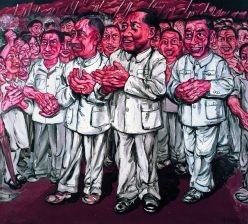Chinese Art Loses Lustre – artmarketblog.com
Copyright@Artprice.com

"From the Masses, to the Masses" by Zeng Fanzhi
In 2007, China redistributed the cards in becoming the third auction market globally. Beijing and Hong Kong have rapidly established themselves as new growth relays and the scene of some particularly aggressive investment over the past two years. The most impressive sale results have been achieved at Poly International Auction and China Guardian. In Hong-Kong, it is Sotheby’s and Christie’s who largely dominate the market, rocking the art market twice a year with their sales of modern and contemporary Asian art: Sotheby’s opens the proceedings in April with Christie’s following in December. The two auction houses had great hopes of 2008 but the year proved to be one of the most disappointing.
Christie’s and Sotheby’s had become accustomed to seeing their Hong Kong sale proceeds increase by several million dollars every six months. Between April and May 2007, they recorded more than USD 120 million, followed by USD 173 million in the October to November period. In the spring of 2008, proceeds soared to USD 198 million. However, the first warning signs were already discernable: nearly 20% of the lots were bought in at Christie’s compared with the usual ratio of between 9% and 14%. In the autumn, their unsold rate reached a high of 35%!
Asian contemporary art, and Chinese in particular, is being hit by the negative fall-out of two years of speculative price rises. It is worth remembering that, on 9 April 2008, Sotheby’s sold 90% of the works in the Estella collection. A private Asian collector spent the equivalent of USD 5.4 million on a work entitled Bloodline: The Big Family No. 3 by Xiaogang ZHANG, a new record for the artist. Six months later, only one of the four Xiaogang ZHANG canvases presented by Sotheby’s was to find a buyer in Hong Kong, with no-one prepared to bid higher than its low-end pre-sale estimate (USD 2.75 million, Bloodline: Big Family No.1). Still in the spring of 2008, Fanzhi ZENG achieved the world record for a contemporary Chinese artist. The work in question was the Mask series 1996 No.6 diptych which changed hands at Christie’s for close to USD 8.6 million (HKD 67 million), five times its pre-sale estimate. On 30 November 2008, Christie’s hoped to repeat this major exploit in again betting on Fanzhi ZENG with From the Masses, to the Masses. This work, created in 1993, had been billed as a “historic work”, heralding the famous Mask series, so sought-after in the market. Advertised as the headline lot of the Asian contemporary art evening sale for a secret pre-sale estimate, the star of the Chinese contemporary art scene would not find a buyer that night… The following day the rate of unsold contemporary works reached 43% at Christie’s. As for modern art, nearly 52% of the lots offered on 1 December were bought in. Only a few private Asian collectors were prepared to bid up for abstract masters like Wou-ki ZAO and Teh-Chun CHU. The best result was achieved by a Wou-ki ZAO abstract work, Hommage à Tou-Fou, sold for the equivalent of USD 5.16 million, a new record for the artist. A readjustment is under way but Asian art prices are maintaining a high level that was unimaginable even three years ago. The first million-ticket sales were effectively recorded in 2005, with prices accelerating in 2007 before peaking in the first half of 2008.
The global economic crisis has put an end to the speculative frenzy and, with collectors becoming more cautious and more demanding, the estimated ranges indicated in the spring of 2009 are going to have to be revised down.
 **Nicholas Forrest is an art market analyst, art critic and journalist based in Sydney, Australia. He is the founder of http://www.artmarketblog.com
**Nicholas Forrest is an art market analyst, art critic and journalist based in Sydney, Australia. He is the founder of http://www.artmarketblog.com , writes the art column for the magazine Antiques and Collectibles for Pleasure and Profit and contributes to many other publications.
, writes the art column for the magazine Antiques and Collectibles for Pleasure and Profit and contributes to many other publications.
Filed under: art, art auction, art investment, art market, art news, artist, arts, fine art | Tagged: art, art auction, art investment, art market, art news, artist, fine art |

































Looks like the whole world is going through a correction. When I first moved back to Maui (three years ago) I was shocked at the prices here. It is good to see an emphasis on value over speculation. The art market, just like so many other markets needs to slim down and slow down.
Wow its amazing how much artists can sell their work for sometimes. The world of fine art is so interesting in that aspect, you never know whos going to be the next big artist!
[…] Chinese Art Loses Lustre – artmarketblog.com […]